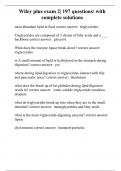Samenvatting
Summary Healthcare Purchasing & Supply Chain (EBM193B05)
Porter, M. E. (2010). What is value in health care. N Engl J Med, 363(26), . Only the main article (not the supplementary material). [LINK] Porter, M. E., Larsson, S., & Lee, T. H. (2016). Standardizing patient outcomes measurement. N Engl J Med, 374(6), 504-506. Noort, B. A., van der Vaart, T...
[Meer zien]













